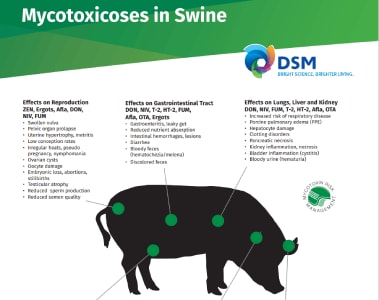
-
North America/EN
- Global
- North America
- Latin America
Optimizing sow longevity and sow performance over a lifetime is the foundation for maximizing sow health, welfare, and performance efficiency of the breeding herd as well as its progeny, leading to a more sustainable swine production. There is a significant cost associated to early culling or the trend for hyper-prolific sows and death of a sow, and sow mortality has been steadily increasing over the last decade. With associated increased metabolic stress, modern sows can be more susceptible to on-farm health, nutrition, and management challenges, leading to higher culling and mortality rates. Among the challenges faced by the breading stock, mycotoxins, present in a wide range of sow feed and raw materials, compromise animal welfare, reduce animal performance, and affect the sustainability and profitability of the entire value chain.
Our local pig experts will work closely with you to assess your mycotoxin risk, both in raw materials and the complete sow feed. We offer different analysis methods that reveal not only the most common mycotoxins, but also hidden and emerging mycotoxins.
You’ll receive a complete, personalized report on your level of risk, and then our experts will advise you on the best solutions to reduce premature sow mortality and support sow health and sow performance, sow longevity and successful sow reproduction.
For nearly 40 years, dsm-firmenich has been innovating unique solutions that not only support the physiological functions of sows, but also have a direct effect on mycotoxins. We’re the only company whose products have received seven EU authorizations, a rigorous certification process that verifies both safety and efficacy, and with multifaceted solutions including:
Contact us to learn more about how we can support you or reach out to your local dsm-firmenich representative.
Watch the on-demand webinar in which you will hear from a host of experts on the susceptibility of modern hyper-prolific sows focusing on challenges from mycotoxins and the impact on longevity and piglet quality.